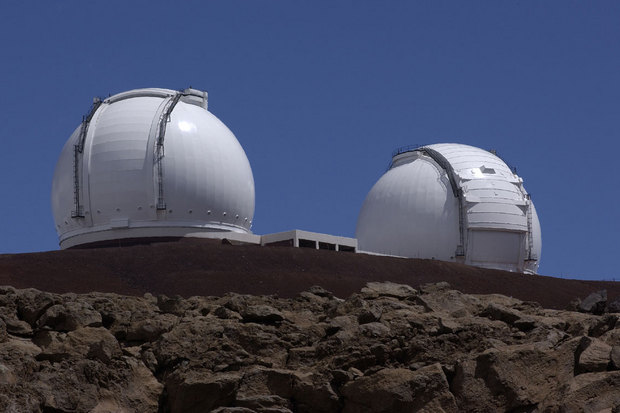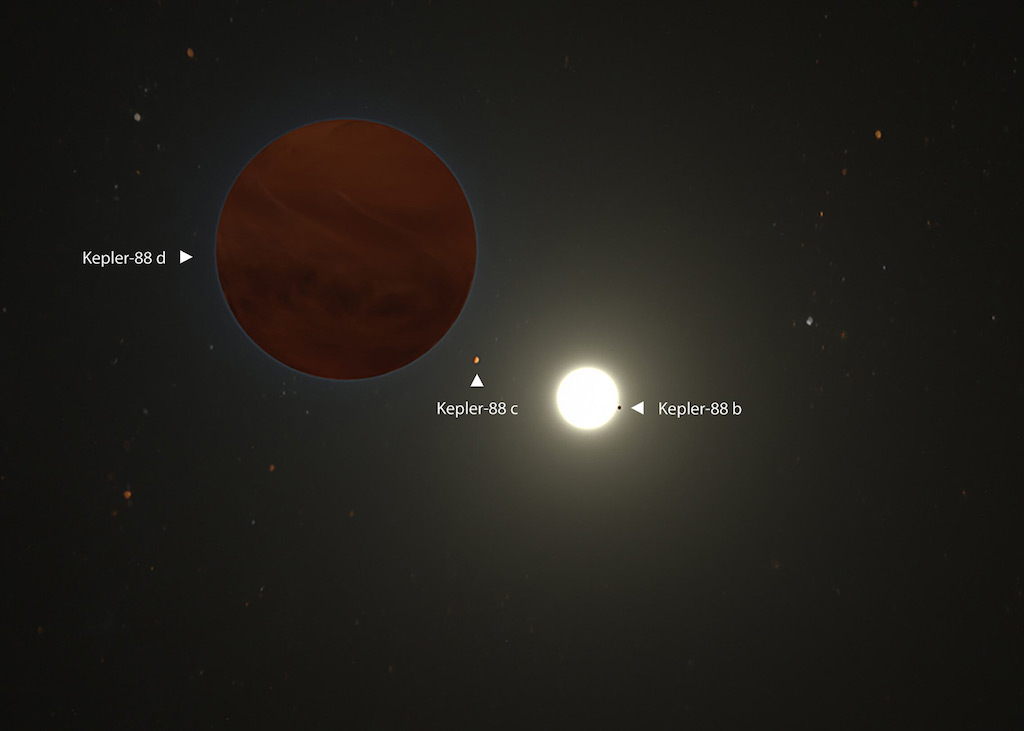Kepler-88 has a new king! Planet three-times Jupiter's mass discovered in alien star system
Orbiting its sun-like star every four years, the giant could play a role in sparking life on rocky worlds.
It appears that planetary heavyweight Kepler-88 c, which orbits the sunlike star Kepler-88, is no longer the gravitational god of the exoplanets in the Kepler-88 system, according to a new study. A new world was recently confirmed in the system, tipping the scales at three times the mass of solar system giant Jupiter.
Led by a team of astronomers at the University of Hawaii Institute for Astronomy (UH IfA), the research — which is based on six years of data taken from W.M. Keck Observatory on Mauna Kea in Hawaii — uncovered a previously undetected third exoplanet orbiting Kepler-88. Named Kepler-88 d, the newfound planet completes slow-moving laps around its host star every four years.
It was the keen telescopic eye of the High-Resolution Echelle Spectrometer (HIRES) instrument affixed to the 10-meter Keck I telescope that revealed to lead author Lauren Weiss, a Beatrice Watson Parrent Postdoctoral Fellow at UH IfA, her team had made a game-changing discovery.
Video: Exoplanet Kepler-88 d is 3X more massive than Jupiter
Related: Another day, another exoplanet, and scientists just can't keep up

"At three times the mass of Jupiter, Kepler-88 d has likely been more influential in the history of the Kepler-88 system than the so-called King, Kepler-88 c, which is only one Jupiter mass," Weiss said. "So maybe Kepler-88 d is the new supreme monarch of this planetary empire — the empress."
The Kepler-88 system, which lies over 1,200 light-years away from Earth in the constellation of Lyra, the harp, has drawn attention from astronomers ever since the discovery of its first two exoplanets in 2013. The observations revealed that Kepler-88 c, the more massive of the two exoplanets, and its gaseous sibling Kepler-88 b appear to interact around their host star in a striking way.
For one, the "sub-Neptune" exoplanet Kepler-88 b completes an orbital lap every 11 days, almost exactly half the time it takes Kepler-88 c to finish a circuit. Since Kepler-88 c, the outer planet, is 20 times more massive than Kepler-88 b, the larger planet's gravity affects the orbit of the inner world when the two planets pass each other in orbit. In other words, for every two orbits Kepler-88 b achieves, it gets "pumped" by its gigantic sibling, according to a statement from the Keck Observatory.
Breaking space news, the latest updates on rocket launches, skywatching events and more!

What astronomers have observed between the alien worlds is a bizarre and striking dynamic known as mean motion resonance; two orbits that seem to behave in a clockwork fashion — it's energetically efficient, according to Weiss and her team, and similar to a parent pushing a child on a swing.
It was with the help of NASA's now-defunct Kepler Space Telescope (which officially ceased operations on Oct. 30, 2018 when the spacecraft ran out of fuel), that the orbital timing of the planets in the Kepler-88 system was gained with precision. Kepler was able to use the art of transits — an exoplanet detection technique in which astronomers watch for planets passing in front if their host stars — to gain the readings, known as transit timing variations.
Although transit timing variations (TTVs) have been detected in a few dozen planetary systems, Kepler-88 b has some of the largest timing variations. With transits arriving up to half a day early or later than predicted, the system is known as "the King of TTVs," the researchers said in the statement.
Heading back to our solar system, Jupiter holds the cards when it comes to being the king of gravitational influence. Twice the mass of ringed giant Saturn and 300 times heftier than Earth, even the slightest movement is felt by the other worlds of cosmic neighborhood: from Mars to the team of comets that — according to observations of comet 46P/Wirtanen — delivered water to a parched young Earth billions of years ago.
Whether Kepler-88 d also has the influence to direct water-bearing comets to newly-developed rocky worlds is of importance to the team of researchers, Weiss said.
The new research was published April 29 in the Astronomical Journal.
- 7 greatest alien planet discoveries by NASA's Kepler spacecraft
- Surprise! 4 alien worlds locked in fragile dance for 6 billion years
- Alien planet quiz: Are you an exoplanet expert?
Gemma Lavender is the author of Quantum Physics in Minutes (Quercus, 2017) and Haynes Owner's Workshop Manual: Milky Way (Haynes Publishing, 2019), among other books. Follow her on Twitter @Gemma_Lavender. Follow us on Twitter @Spacedotcom and on Facebook.
OFFER: Save 45% on 'All About Space' 'How it Works' and 'All About History'!
For a limited time, you can take out a digital subscription to any of our best-selling science magazines for just $2.38 per month, or 45% off the standard price for the first three months.
Join our Space Forums to keep talking space on the latest missions, night sky and more! And if you have a news tip, correction or comment, let us know at: community@space.com.

Gemma currently works for the European Space Agency on content, communications and outreach, and was formerly the content director of Space.com, Live Science, science and space magazines How It Works and All About Space, history magazines All About History and History of War as well as Science, Technology, Engineering, Arts and Mathematics (STEAM) kids education brand Future Genius. She is the author of several books including "Quantum Physics in Minutes", "Haynes Owners’ Workshop Manual to the Large Hadron Collider" and "Haynes Owners’ Workshop Manual to the Milky Way". She holds a degree in physical sciences, a Master’s in astrophysics and a PhD in computational astrophysics. She was elected as a fellow of the Royal Astronomical Society in 2011. Previously, she worked for Nature's journal, Scientific Reports, and created scientific industry reports for the Institute of Physics and the British Antarctic Survey. She has covered stories and features for publications such as Physics World, Astronomy Now and Astrobiology Magazine.
-
rod "Orbiting its sun-like star every four days, the giant could play a role in sparking life on rocky worlds." The beginning of the report here is incorrect, it is about 4 years orbital period as correctly reported shortly after in the article. Kepler-88 is a star system with multiple giant planets, others are known now too. Kepler-88 is considered to be about 0.985 solar masses, https://ui.adsabs.harvard.edu/abs/2020AJ....159..242W/abstract, arxiv report attached. 88 d is about 2.4 AU from the star with large eccentric orbit, 0.41. Exoplanet systems like this are a good example of what Sky & Telescope said recently about other planets and solar systems.Reply
"...But we now know that a model based only on our solar system is misleading. From systems where planets orbit two stars instead of just one (Kepler-16b) to those with Jupiter-mass planets on orbits of just a few days (Kepler-435b), our observations since the first exoplanet discoveries in the mid-1990s have continuously surprised us with a puzzling diversity of system architectures. Our solar system is not the blueprint we once assumed it was.", Revising the Story of Planet Formation, Sky & Telescope 139(5):34-40, 2020.
Just think if this multiple giant planet configuration *evolved* here. There would likely be no Earth :) -
Lovethrust Reply
Of course we could then be floating intelligent gasbags wondering if those little rockballs could possibly host life!rod said:"Orbiting its sun-like star every four days, the giant could play a role in sparking life on rocky worlds." The beginning of the report here is incorrect, it is about 4 years orbital period as correctly reported shortly after in the article. Kepler-88 is a star system with multiple giant planets, others are known now too. Kepler-88 is considered to be about 0.985 solar masses, https://ui.adsabs.harvard.edu/abs/2020AJ....159..242W/abstract, arxiv report attached. 88 d is about 2.4 AU from the star with large eccentric orbit, 0.41. Exoplanet systems like this are a good example of what Sky & Telescope said recently about other planets and solar systems.
"...But we now know that a model based only on our solar system is misleading. From systems where planets orbit two stars instead of just one (Kepler-16b) to those with Jupiter-mass planets on orbits of just a few days (Kepler-435b), our observations since the first exoplanet discoveries in the mid-1990s have continuously surprised us with a puzzling diversity of system architectures. Our solar system is not the blueprint we once assumed it was.", Revising the Story of Planet Formation, Sky & Telescope 139(5):34-40, 2020.
Just think if this multiple giant planet configuration *evolved* here. There would likely be no Earth :)

